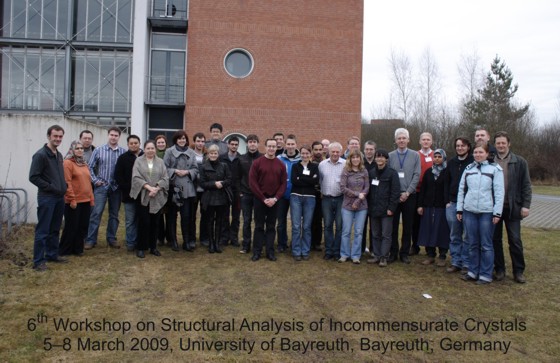6th Workshop on Structural
Analysis of Incommensurate Crystals
5 – 8 March 2009
Laboratory of Crystallography, University of Bayreuth, Address
|
· Report · Photos · Updates · Program |

Click on the photo to enlarge.
ReportIn the period March 5 - 8, 2009 (Thursday to Sunday) the 6th Workshop on Structural Analysis of Incommensurate Crystals took place at the University of Bayreuth. This workshop was organized by Sander van Smaalen on behalf of the special interest group 16: Aperiodic Crystals of the German Crystallographic Association (DGK) and the Laboratory of Crystallography of the University of Bayreuth, Germany. Topics were the general foundations and theory of superspace and the actual methods of structure determination and crystal-chemical analysis of incommensurately modulated structures and incommensurate composite crystals. The workshop was with 31 participants completely booked-out. They came from Germany (14), Russia (5), Switzerland (4), the USA (4), the Czech Republic (1), Spain (1), Poland (1) and India (1). The six speakers/tutors were Vaclav Petricek and Michal Dusek (both from Prague, Czech Republic), Lukas Palatinus (Lausanne, Switzerland), Nadezhda Bolotina (Moscow, Russia), as well as Andreas Schönleber and Sander van Smaalen (both from the Laboratory of Crystallography of the University of Bayreuth, Germany). The German Crystallographic Association (DGK) is acknowledged for the generous financial support, which made it possible to carry out this workshop. The participation of east-European scientists was supported by travel grants of the German Research Foundation (DFG). The first lectures with titles Aperiodic order in crystalline materials, Superspace description of modulated structures, Superspace symmetry and Diffraction by incommensurate structures served as introduction to the topic. Aim was here to give a general overview and to introduce into the fundamentals of the (3+d)-dimensional superspace approach as mathematical tool for the description of crystal structures of incommensurately modulated compounds and incommensurate composite crystals. The following talks Fourier methods in superspace and Modulation functions by the Maximum Entropy Method presented modern developments for the proper finding of atomic modulation functions. The talk Structure solution by Charge-Flipping presented a method of ab initio structure determination of periodic and of aperiodic crystals from X-ray diffraction data, with which crystal structures of aperiodic crystals can be determined directly in higher-dimensional superspace. Finally, the contributions on Commensurately and incommensurately modulated structures of Lazurite minerals - a case study, Disorder and aperiodic order and Modulated molecular compounds treated the application of the superspace approach for a unified and simplified description of complex superstructures, crystal-chemical aspects of aperiodic structures and potential problems and their solution during measurement and data collection. An important part of the workshop was the working with the computer. While the lectures took place in the morning, in the afternoon the participants had - after the lecture Introduction to Jana2006 - the possibility to practice structure refinement and structure solution of incommensurate crystals on their own desktop computers. To do so all necessary software and computer programs like Jana2006 (V. Petricek, M. Dusek and L. Palatinus, Prague) and Superflip (L. Palatinus and G. Chapuis, Lausanne) had been installed on the computers in a computer room of the Bayreuth university data centre. A script with selected examples of different level of difficulty gave a step by step introduction into the procedure of structure analysis of aperiodic crystals. The questions and exercises in the script served as motivation, to work out the various aspects of structure analysis in superspace, as for example the symmetry relations between the model parameters. During this practical training the lecturers served as tutors, to discuss, to help and to advice and to solve all kinds of small and big problems immediately. For the working on the computer and the exercises about half of the total workshop time was used. The participants are working in inorganic and organic solid state chemistry, solid state physics, metallurgy, biochemistry, structural biology and in pharmaceutical industry. This shows, that in all branches of crystallography there is still a continuous and unreduced interest in the topic of aperiodic crystals. Due to the positive feedback of the participants in this and in the last courses, the 7th Workshop on Structural Analysis of Incommensurate Crystals is scheduled for spring 2011. Andreas Schönleber, Bayreuth, Germany
|